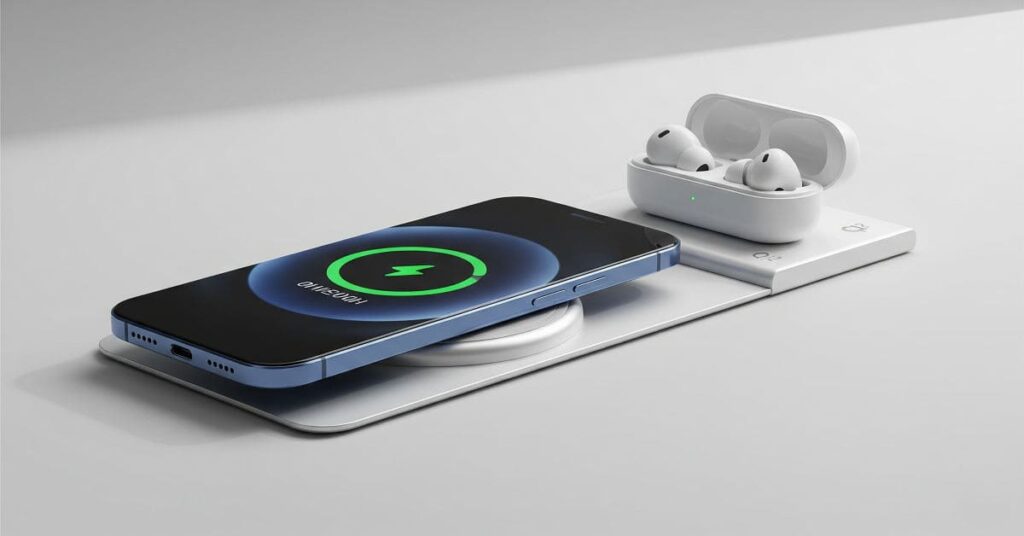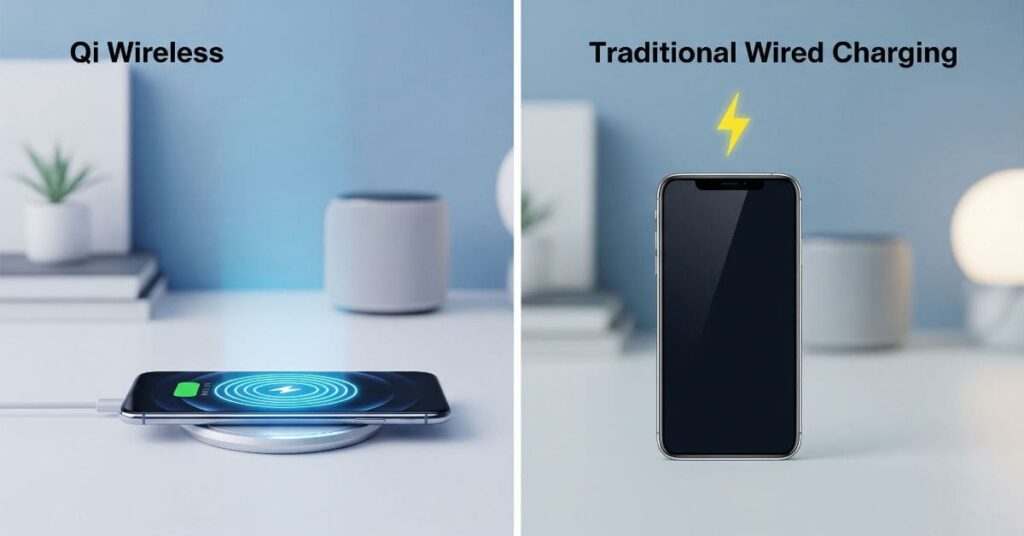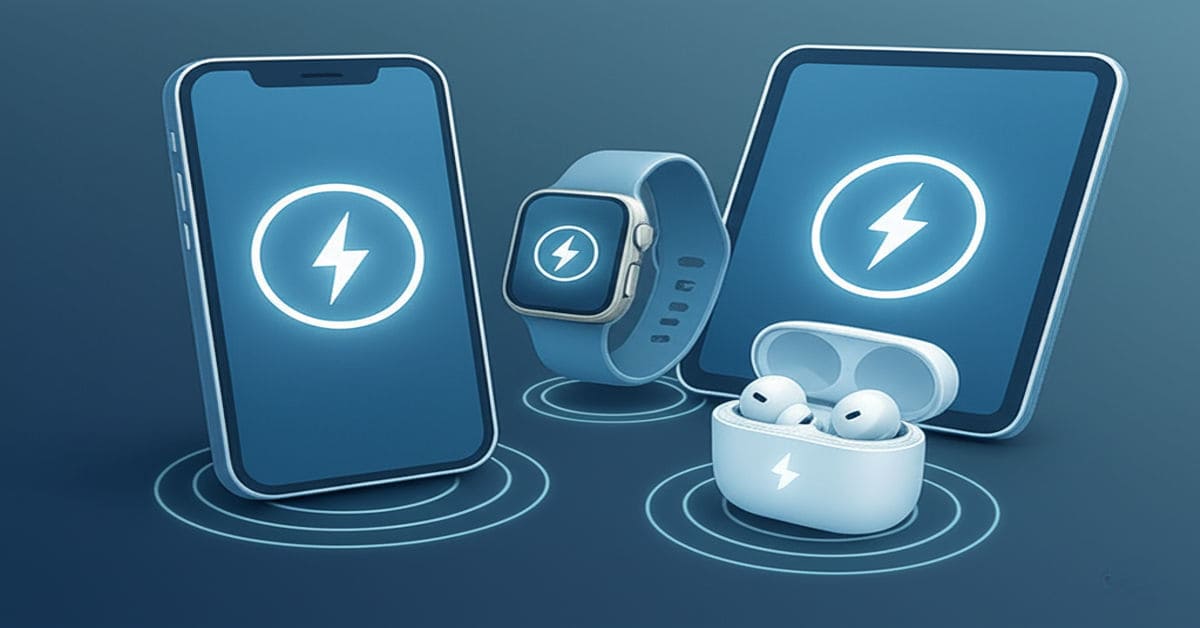Introduction
Wireless charging is fantastic — place your phone and it starts charging. However, first, it is important to know whether your phone supports Qi or Qi2. In this article, we will explain in simple terms how to check compatibility, the benefits of Qi vs Qi2, how this technology works, and tips to get the best charging experience.
Table of Contents
Is My Phone Compatible with Qi / Qi2 Wireless Charging?
Wireless charging sounds excellent, right? Just drop your phone on a pad and let it power up—no tangled cables. However, before you buy a Qi or Qi2 charger, you might be wondering: Is my device even compatible? Let us break it down.
How to Check If Your Phone Supports Qi / Qi2
1. Look up your phone specs
The fastest way is to visit the official manufacturer’s site or Google your phone model with the phrase “wireless charging”. This usually tells you whether it supports Qi or Qi2.
2. Know the model shorthand
Most modern flagship phones (like iPhones from iPhone 8 onward, and premium Samsung Galaxy or Pixel models) already support Qi. Mid-range or budget phones might not.
3. Check the packaging or settings
Sometimes the box or quick-start guide will mention “Qi Wireless Charging.” On certain phones, you can also look under Battery Settings for wireless charging toggles.
4. Use compatibility lists or apps
Websites like the Wireless Power Consortium’s database or even third-party apps can confirm what devices are Qi-enabled—handy if you are not sure.
5. Try charging it: If you have access to a Qi charging pad, place your phone on it. If the phone starts charging, then it is Qi-compatible. If nothing happens, your phone probably lacks Qi support. Either way, the phone will not be harmed by this. It is a simple, no-risk way to confirm wireless charging capability in practice.
When Qi vs Qi2 Matters
Backward compatibility
The good news? Qi2 is backwards compatible. If your device only supports Qi, it will still charge on a Qi2 pad (just without the extra perks).
Magnetic alignment
Qi2 adds MagSafe-style magnets, so if you want magnetic accessories—like car mounts or snap-on wallets—you will need a Qi2-supported phone. Otherwise, a regular Qi charger works fine.
Qi-Enabled Devices and Accessories (2024–2025)

Smartphones
| Device / Brand | Qi Support | Qi2 / MagSafe Compatibility | Notes / Details |
|---|---|---|---|
| Apple iPhones | All models from iPhone 8/8 Plus onward | 12 series and later support Qi2 via MagSafe | iPhone 12/12 mini/12 Pro/12 Pro Max (2020), 13 series (2021), 14 series (2022), 15 series (2023) charge up to 15 W and are Qi2-compatible. Older Qi-only iPhones (iPhone 8/X/XR/XS/XS Max and iPhone 11/11 Pro/11 Pro Max) lack MagSafe magnets and charge up to 7.5 W. |
| Samsung Galaxy | Most recent Galaxy phones | Galaxy S25 lineup (expected 2025) Qi2-ready with magnetic case | All high-end Galaxy S/Note/Z models from ~2017 onward include Qi. Galaxy S8/S8+ (2017) up through S23 series (2023) and Note8/9/10/20 have Qi wireless charging. Foldables (Galaxy Z Flip/Fold series since 2019) also support Qi. No built-in magnets for S25, charges at 15 W with Qi2-compatible magnetic case. |
| Google Pixel | Pixel 4 and later (Pixel 4, 5, 6/6 Pro, 7/7 Pro, 8/8 Pro) | No Pixel phones currently use Qi2 | Pixel 3 also supported Qi, but Pixel 3a/4a/5a do not. Pixel Stand accessories charge Qi-certified Pixel (Pixel 4+) at 10–23 W. Qi2 not announced as of 2025. |
| OnePlus | Recent “Pro” models | Qi2 not available as of 2024 | OnePlus 8 Pro (2020), OnePlus 9 Pro (2021), OnePlus 10 Pro (2022) support 15 W Qi wireless charging. OnePlus 11 (2023) removed wireless charging. |
| Other Android | Many Huawei P/Mate series, Xiaomi Mi/12/13/14 series, etc. | MagSafe-like Qi2 not yet common | Most modern Android phones with metal/glass backs support Qi. Only Samsung’s announced S25 is Qi2-ready. |
Tablets & E-Readers
| Device Type | Model / Example | Qi Support Details | Notes |
|---|---|---|---|
| Amazon Fire Tablets | Fire HD 8 Plus (10th/12th gen, 2020/2022) | Built-in Qi receiver; supports Qi wireless charging with Amazon’s charging dock | Fire HD 8 Plus ships with a wireless charging dock |
| Amazon Fire Tablets | Fire HD 10 Plus (11th gen, 2021) | Supports Qi wireless charging with Amazon’s charging dock (up to 15 W) | Can use a Qi dock; newer standard Fire HD tablets (2023 models) dropped Qi support |
| Kindle E-Readers | Kindle Oasis (7th gen, 2017) | Supported Qi with a special charging cover | Last Kindle Oasis to support Qi |
| Kindle E-Readers | Kindle Paperwhite Signature Edition (2021) | Supports Qi charging via Amazon’s optional wireless charging dock | Current Kindle and Kobo models otherwise lack built-in Qi |
| Others | Apple iPads | No Qi support | Mainstream tablets generally lack Qi |
| Others | Lenovo Yoga Tab models (e.g. Yoga Tab 3, 2016) | Included Qi | Legacy devices |
| Others | Specialty e‑ink tablets (Onyx Boox series) | Currently lack wireless charging | Specialty tablets |
Accessories
| Category | Examples / Details |
|---|---|
| Wireless Charging Pads and Stands | Many Qi-certified chargers are on the market. Top-rated examples include Belkin’s Boost Charge Pro 3-in-1 Wireless Charging Pad (MagSafe, 15 W for iPhone 12–15) 8, OtterBox’s 15 W Wireless Charging Pad (slim, includes USB-C adapter) 9 1 10, Satechi’s 3-in-1 Foldable Qi2 Wireless Charging Stand (2023) which supports Qi2 (magnetic) charging at 15 W. Other popular models are Anker’s PowerWave pads/stands, Mophie 3-in-1 chargers (MagSafe-compatible), Nomad Base Station series, and Zens/Galaxy Duo chargers. Apple’s own MagSafe Charger (2020) is Qi2-certified 11 (delivering up to 15 W for iPhone 12+). |
| Portable Power Banks (with Qi) | Several battery packs can wirelessly charge a phone via Qi. For Apple users, Apple’s MagSafe Battery Pack (2021) delivers up to 7.5 W wirelessly. Third-party packs include Anker’s MagGo series (e.g. 633 Magnetic Battery, 10,000 mAh, Qi/MagSafe output), Anker’s Zolo 10K Magnetic (10 000 mAh, 7.5 W output) Qi2 (15 W) 14 13 12, Baseus Nomos Magnetic Power Bank, EcoFlow RIVER/Power stations with Qi mats, and Ugreen/Aukey Qi2-enabled power banks. These often combine a built-in USB-C cable for fast wired output with a magnetic Qi pad for iPhones. |
| Wireless Car Chargers | Qi-enabled car mounts are widely available. Notable examples include Belkin’s Boost Charge Pro 2-in-1 Wireless Car Charger (MagSafe mount) and Mophie’s Snap+ Wireless Vent Mount (2023, Qi2-certified MagSafe car charger). iOttie, Anker, and Spigen also make Qi car mounts (vent/clamp/windshield) that hold and charge any Qi phone. Some Samsung phones can also FastCharge on special Samsung car chargers. |
| Earbud Cases (Qi) | Many true-wireless earbud cases support Qi. For example, Apple AirPods (Gen 2 with wireless case, Gen 3, and both AirPods Pro 1st and 2nd gen) can be charged on any Qi mat. Samsung Galaxy Buds (original Buds, Buds+/Live/Pro/2/2 Pro and Buds FE) all charge wirelessly by placing the case on a Qi pad. Google Pixel Buds Pro and Pixel Buds A-Series (2023) support Qi. Many other brands (Jabra Elite, Sony WF-1000X series, etc.) also offer Qi charging cases. 15 16 17 |
| Magnetic Adapters/Rings/Cases | To add magnetic alignment to non-MagSafe phones, several kits exist. Scosche’s MagicRing™ MagSafe Adapter (sold in 2‑packs) uses strong N52 magnets and permits pass-through Qi charging. iOttie’s Magnetic Ring Adapter ($15) similarly adheres to any phone/case and allows Qi/MagSafe charging. There are also adhesive magnetic rings (from third-party brands) and case attachments (e.g. PopSockets PopGrip mags, ESR HaloLock rings). Conversely, many phone cases now include magnets: for example Apple’s MagSafe cases (leather, silicone) for iPhone, Spigen and OtterBox MagSafe-compatible cases, and Pitaka MagEZ cases for Pixel/OnePlus that add built-in magnets for Qi2. |
Comparison of some common Qi device categories (Qi vs. Qi2 support)
| Category | Examples (Year) | Qi | Qi2 (Magnetic) |
|---|---|---|---|
| iPhones | 8 / 8 Plus (2017); X / XS / XR (2018); 11 / Pro (2019) | ✓ (7.5 W) | ✗ (no magnets) |
| 12 series (2020) | ✓ (12–15 W) | ✓ (15 W via MagSafe) | |
| 13 series (2021) | ✓ (12–15 W) | ✓ (15 W via MagSafe) | |
| 14 series (2022) | ✓ (15 W) | ✓ (15 W via MagSafe) | |
| 15 series (2023) | ✓ (15 W) | ✓ (15 W via MagSafe) | |
| Samsung | Galaxy S8 / S9 / … / S23 (2017–2023) | ✓ (up to 15 W) | ✗ (no magnets built‑in) |
| Galaxy Z Flip / Fold (2019–2023) | ✓ (up to 15 W) | ✗ (no magnets) | |
| Galaxy Note 8 / 9 / … / 20 (2017–2020) | ✓ (up to 15 W) | ✗ | |
| Galaxy S25 (2025) | ✓ (15 W) | Qi2-ready w/ case | |
| Google Pixel | Pixel 4 / 4XL, 5, 6 / 6 Pro, 7 / 7 Pro, 8 / 8 Pro | ✓ (7.5–23 W) | ✗ |
| OnePlus | OnePlus 8 Pro (2020); 9 Pro (2021); 10 Pro (2022) | ✓ (15 W) | ✗ |
| Earbud Cases | AirPods (Qi case, 2019+); Galaxy Buds series; Pixel Buds Pro | ✓ (Qi) | ✗ |
| Chargers | Belkin / Mophie / Anker pads & stands (2020s) | ✓ (Qi) | Some (Qi2-certified models) |
| Apple MagSafe Charger (2020) | ✓ (Qi, up to 15 W) | ✓ (Qi2-certified) |
How Qi Wireless Charging Works
If you’ve ever wondered what devices are Qi-enabled and how they charge without plugging in a cable, it all comes down to some clever physics—made simple.
Induction Basics: Coil → Electromagnetic Field → Coil
At the heart of Qi wireless charging is induction. Think of it like this:
- Your charging pad has a tiny coil inside it.
- When you place your Qi-enabled device on the pad, electricity in the pad’s coil creates an electromagnetic field.
- Your device has its coil, which captures this field and turns it back into electricity to charge the battery.
It’s almost like magic, but it’s just innovative science. The electricity “jumps” through the air without any wires connecting your phone or gadget to the charger.
Power Transfer, Alignment, and Power Negotiation
Charging wirelessly isn’t just about putting your device on a pad—it’s about alignment and communication. Here’s why:
- Alignment Matters: The coils in your device and charger need to line up. Misalignment can slow charging or even stop it altogether. Many pads have magnets to help keep your device perfectly in place.
- Power Negotiation: Your device and charger “talk” to each other using a tiny chip called a PMIC (Power Management Integrated Circuit). This ensures your device gets just the right amount of power—fast enough to charge efficiently, but safe enough to avoid overheating.
Practical Tip: Always center your phone on the charging pad. Even a slight shift can reduce charging speed, and some devices won’t start charging at all if the coils aren’t aligned.
Benefits of Using Qi Wireless Charging
Qi wireless charging isn’t just a cool tech trend—it makes daily life easier in several practical ways.
1. Convenience & Reduced Wear on Ports
With Qi wireless charging, you place your device on a charging pad—no more fiddling with cables. This not only saves time but also prevents wear and tear on your phone’s charging port, helping it last longer. For people who charge their devices multiple times a day, this is a huge win.
2. Safety Features
Most Qi chargers come with built-in safety measures like over-current protection and foreign object detection. This means your device is safeguarded against overheating or accidental short circuits, making wireless charging safer than plugging in a cord repeatedly.
3. Speed Improvements & Power Profiles
Modern Qi chargers support varying power outputs. Depending on your device, they can adjust the charging speed automatically. This ensures faster, efficient charging without overheating, so your device is ready when you need it.
4. Ecosystem & Accessory Availability
Qi charging is widely supported across smartphones, earbuds, smartwatches, and even some laptops. Accessories like stands, car mounts, and bedside chargers make it easy to integrate Qi charging into your daily routine. Knowing what devices are Qi-enabled helps you pick the right accessories and fully enjoy the ecosystem.
Qi Charging vs Traditional Wired Charging

Quick comparison (table)
| Factor | Qi (wireless) | Wired |
| Speed | Slower | Faster |
| Efficiency | Lower (loss) | Higher |
| Convenience | Very easy (drop & go) | Requires cable |
| Cost | Charger + pad | Usually cheaper |
| Heat | More heat | Less heat |
| Interoperability | Universal Qi standard | Depends on cable/port |
If you ask what devices are Qi-enabled, many modern phones (iPhone, Samsung, Google Pixel, higher-end), earbuds, and some watches support Qi. Check specs before buying a pad.
When to choose wired vs wireless
- Use wired for fast charging, heavy use (gaming), or when the battery tops up quickly.
- Use Qi wireless for convenience (desk/bedside), reduced cable wear, and tidy setups.
- Tip: Keep the phone case thin, align coils, and choose a certified Qi charger to reduce heat and improve efficiency.
Qi2 Technology and Its Advantages
Magnetic Alignment & Standardized Magnets
Qi2 technology brings standardized magnets to wireless charging. This means your device snaps perfectly onto the charger every time, reducing misalignment and wasted energy. It’s a game-changer for anyone tired of repositioning phones while charging.
Improved Efficiency & Power Delivery
With Qi2, expect higher efficiency and stable power delivery. Your devices charge faster and more reliably, avoiding overheating and interruptions. This makes everyday charging smoother and safer for your battery.
Better Interoperability
Qi2 works across a wide range of devices. You no longer need separate chargers for different brands—as long as you know what devices are Qi-enabled, you’re good to go.
Conclusion
Wireless charging is easy and widely supported—check your phone’s specs or try a pad to confirm. Qi works with most modern devices; Qi2 adds magnetic alignment and better efficiency. Remember the basics: center the phone, keep cases thin, and choose a certified charger for safety and speed.
Ready to switch? Look up your model, test with a pad, and if you want magnetic snap-on convenience, pick a Qi2-certified charger. If this helped, save the post or drop a question below — I’ll help you choose the correct charger.
FAQs
How do I know if my device is Qi-enabled?
Check if your phone supports wireless charging by searching your phone model along with terms like “Qi” or “wireless charging.” You can also find this information on the manufacturer’s official website or in your phone’s settings. An easy way to check is by putting your phone on a Qi wireless charger—if it starts charging, your device supports Qi.
What devices have Qi charging?
Most contemporary smartphones, tablets, earbuds, and accessories support Qi wireless charging. Devices like iPhones (from iPhone 8 onwards), high-end Samsung Galaxy models (S8 and newer), Google Pixel 4 and above, and OnePlus Pro series are all compatible with Qi charging.
Is an iPhone a Qi-enabled device?
Yes, Qi wireless charging is supported on the iPhone 8 and all subsequent models. Additionally, iPhone 12 and later devices are compatible with MagSafe (Qi2) technology.
Is Samsung a Qi-enabled device?
Yes, Qi wireless charging is supported on Samsung Galaxy S8 and all later high-end models, including the S, Note, and Z series.
Are all Android phones Qi-enabled?
No, Qi wireless charging is not available on all Android phones. It is typically found on modern mid-range and high-end devices with glass or metal backs, while most budget models lack this feature.
Discover more from Snap Charge Hub
Subscribe to get the latest posts sent to your email.
